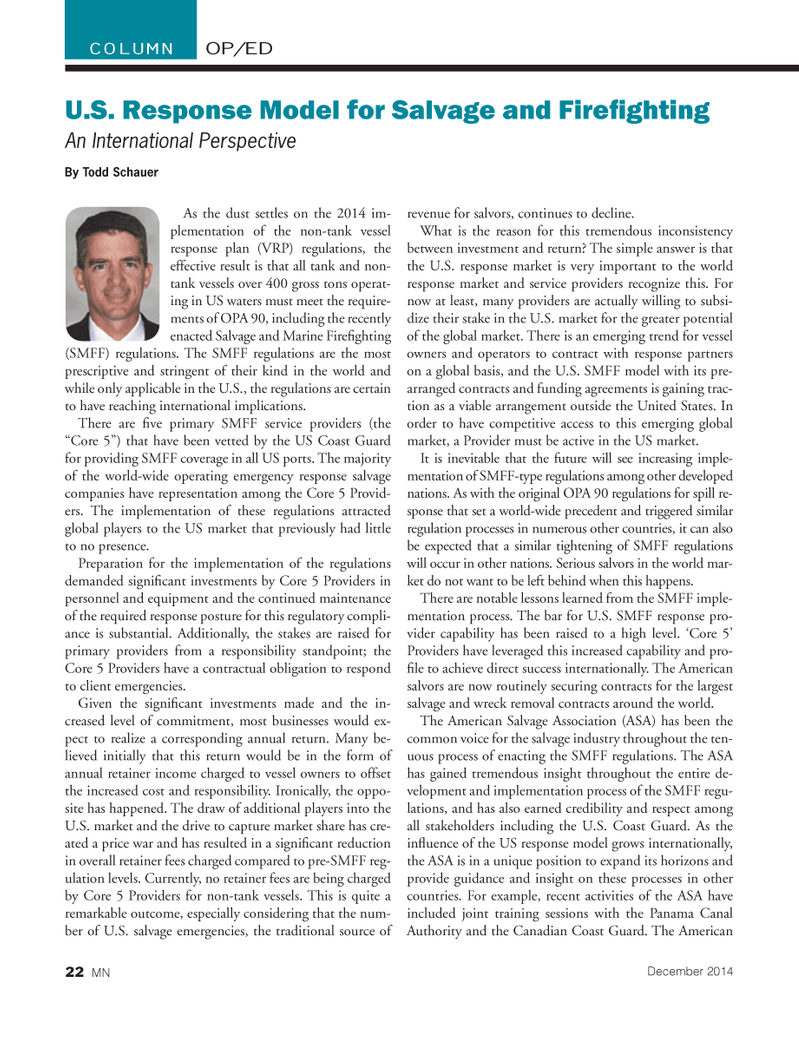
Page 22: of Marine News Magazine (December 2014)
Salvage & Spill Response
Read this page in Pdf, Flash or Html5 edition of December 2014 Marine News Magazine
As the dust settles on the 2014 im-plementation of the non-tank vessel response plan (VRP) regulations, the effective result is that all tank and non- tank vessels over 400 gross tons operat- ing in US waters must meet the require- ments of OPA 90, including the recently enacted Salvage and Marine FireÞ ghting (SMFF) regulations. The SMFF regulations are the most prescriptive and stringent of their kind in the world and while only applicable in the U.S., the regulations are certain to have reaching international implications. There are Þ ve primary SMFF service providers (the ÒCore 5Ó) that have been vetted by the US Coast Guard for providing SMFF coverage in all US ports. The majority of the world-wide operating emergency response salvage companies have representation among the Core 5 Provid- ers. The implementation of these regulations attracted global players to the US market that previously had little to no presence. Preparation for the implementation of the regulations demanded signiÞ cant investments by Core 5 Providers in personnel and equipment and the continued maintenance of the required response posture for this regulatory compli- ance is substantial. Additionally, the stakes are raised for primary providers from a responsibility standpoint; the Core 5 Providers have a contractual obligation to respond to client emergencies.Given the signiÞ cant investments made and the in- creased level of commitment, most businesses would ex- pect to realize a corresponding annual return. Many be- lieved initially that this return would be in the form of annual retainer income charged to vessel owners to offset the increased cost and responsibility. Ironically, the oppo- site has happened. The draw of additional players into the U.S. market and the drive to capture market share has cre- ated a price war and has resulted in a signiÞ cant reduction in overall retainer fees charged compared to pre-SMFF reg- ulation levels. Currently, no retainer fees are being charged by Core 5 Providers for non-tank vessels. This is quite a remarkable outcome, especially considering that the num- ber of U.S. salvage emergencies, the traditional source of revenue for salvors, continues to decline. What is the reason for this tremendous inconsistency between investment and return? The simple answer is that the U.S. response market is very important to the world response market and service providers recognize this. For now at least, many providers are actually willing to subsi- dize their stake in the U.S. market for the greater potential of the global market. There is an emerging trend for vessel owners and operators to contract with response partners on a global basis, and the U.S. SMFF model with its pre- arranged contracts and funding agreements is gaining trac- tion as a viable arrangement outside the United States. In order to have competitive access to this emerging global market, a Provider must be active in the US market. It is inevitable that the future will see increasing imple- mentation of SMFF-type regulations among other developed nations. As with the original OPA 90 regulations for spill re- sponse that set a world-wide precedent and triggered similar regulation processes in numerous other countries, it can also be expected that a similar tightening of SMFF regulations will occur in other nations. Serious salvors in the world mar- ket do not want to be left behind when this happens.There are notable lessons learned from the SMFF imple- mentation process. The bar for U.S. SMFF response pro- vider capability has been raised to a high level. ÔCore 5Õ Providers have leveraged this increased capability and pro- Þ le to achieve direct success internationally. The American salvors are now routinely securing contracts for the largest salvage and wreck removal contracts around the world. The American Salvage Association (ASA) has been the common voice for the salvage industry throughout the ten- uous process of enacting the SMFF regulations. The ASA has gained tremendous insight throughout the entire de- velopment and implementation process of the SMFF regu- lations, and has also earned credibility and respect among all stakeholders including the U.S. Coast Guard. As the inß uence of the US response model grows internationally, the ASA is in a unique position to expand its horizons and provide guidance and insight on these processes in other countries. For example, recent activities of the ASA have included joint training sessions with the Panama Canal Authority and the Canadian Coast Guard. The American OP/EDCOLUMNU.S. Response Model for Salvage and Fire Þ ghting An International PerspectiveBy Todd Schauer 22 MNDecember 2014MN Dec14 Layout 18-31.indd 22MN Dec14 Layout 18-31.indd 2211/25/2014 10:18:26 AM11/25/2014 10:18:26 AM

 21
21

 23
23
